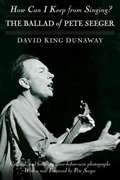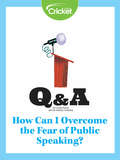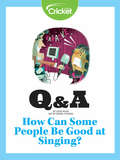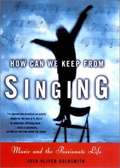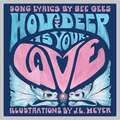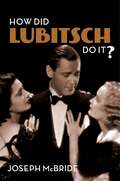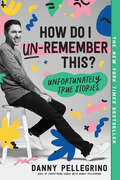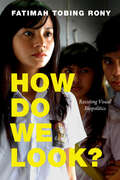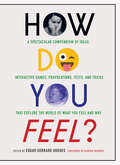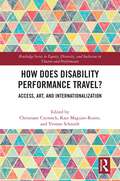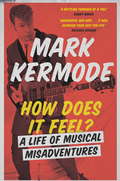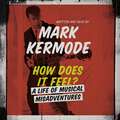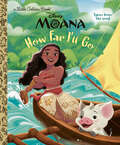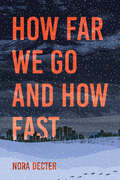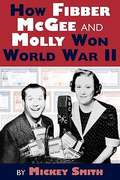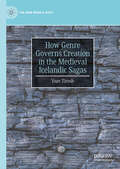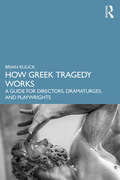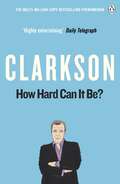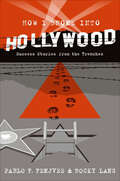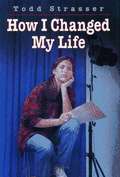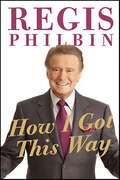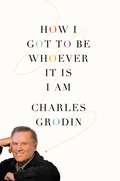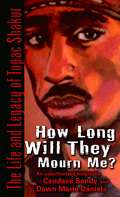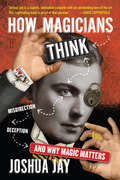- Table View
- List View
How Can I Keep from Singing?: The Ballad of Pete Seeger
by David King DunawayHow Can I Keep from Singing? is the compelling story of how the son of a respectable Puritan family became a consummate performer and American rebel. Updated with new research and interviews, unpublished photographs, and thoughtful comments from Pete Seeger himself, this is an inside history of the man Carl Sandburg called "America's Tuning Fork." In the only biography on Seeger, David Dunaway parts the curtains on his life. Who is this rail-thin, eighty-eight-year-old with the five-string banjo, whose performances have touched millions of people for more than seven decades? Bob Dylan called him a saint. Joan Baez said, "We all owe our careers to him." But Seeger's considerable musical achievements were overshadowed by political controversy when he became perhaps the most blacklisted performer in American history. He was investigated for sedition, harassed by the FBI and the CIA, picketed, and literally stoned by conservative groups. Still, he sang. Today, Seeger remains an icon of conscience and culture, and his classic antiwar songs, sung by Bruce Springsteen and millions of others, live again in the movement against foreign wars. His life holds lessons for surviving repressive times and for turning to music to change the world. "This biography is a beauty. It captures not only the life of the bard but the world of which he sings." --Studs Terkel "A fine and meticulous biography ... Dunaway has taken [Seeger's] materials and woven them into a detailed, interesting, and well-written narrative of a most fascinating life." -American Music. "An extraordinary tale of an extraordinary man [that] will intrigue not only his legions of followers but everyone interested in one man's battles and victories." -Chicago Sun-Times.
How Can I Overcome the Fear of Public Speaking?
by Lizzie WadeSome people are afraid of public speaking more than others. Learn about some surprising ways to overcome stage fright.
How Can Some People Be Good at Singing?
by Lizzie WadeSome people are better at singing than others. Why is that? A researcher explains why some people love doing karaoke, and others simply can't do it.
How Can We Keep from Singing: Music and the Passionate Life
by Joan Oliver GoldsmithThe author has been a member of the Minneapolis/St. Paul Symphony Chorus for eight years, and has a lifelong love of choral singing. This book combines memoir with far-ranging reflections on singing, friendship, the corporate world, romantic love, and much more. Goldsmith writes beautifully and her words capture the beauty and exhilaration of singing, which she considers a spiritual experience.
How Deep Is Your Love: A Children's Picture Book
by Bee GeesA majestic picture book based on the Bee Gees's classic love song "How deep is your love? I really mean to learn 'Cause we're living in a world of fools Breaking us down When they all should let us be We belong to you and me . . ." How Deep Is Your Love is a fantastical picture book based on one of the Bee Gees's biggest hits. The song topped the Billboard Hot 100 chart, remaining in the top ten for seventeen weeks, and won the band's first of eight GRAMMY awards. With lyrics by the Bee Gees and illustrations by J.L. Meyer, the picture book tells the tale of two bunny mermaids who meet on a rock and descend into the water together. As the bunnies escape traps, skirt around nets and hooks, and protect each other in this thrilling adventure, they realize how deep their love is. Meyer's imaginative story compliments the hit song perfectly and will delight children and adults alike.
How Did Lubitsch Do It?
by Joseph McBrideOrson Welles called Ernst Lubitsch (1892–1947) “a giant” whose “talent and originality are stupefying.” Jean Renoir said, “He invented the modern Hollywood.” Celebrated for his distinct style and credited with inventing the classic genre of the Hollywood romantic comedy and helping to create the musical, Lubitsch won the admiration of his fellow directors, including Alfred Hitchcock and Billy Wilder, whose office featured a sign on the wall asking, “How would Lubitsch do it?” Despite the high esteem in which Lubitsch is held, as well as his unique status as a leading filmmaker in both Germany and the United States, today he seldom receives the critical attention accorded other major directors of his era.How Did Lubitsch Do It? restores Lubitsch to his former stature in the world of cinema. Joseph McBride analyzes Lubitsch’s films in rich detail in the first in-depth critical study to consider the full scope of his work and its evolution in both his native and adopted lands. McBride explains the “Lubitsch Touch” and shows how the director challenged American attitudes toward romance and sex. Expressed obliquely, through sly innuendo, Lubitsch’s risqué, sophisticated, continental humor engaged the viewer’s intelligence while circumventing the strictures of censorship in such masterworks as The Marriage Circle, Trouble in Paradise, Design for Living, Ninotchka, The Shop Around the Corner, and To Be or Not to Be. McBride’s analysis of these films brings to life Lubitsch’s wit and inventiveness and offers revealing insights into his working methods.
How Do I Un-Remember This?: Unfortunately True Stories
by Danny PellegrinoFrom the host of Everything Iconic with Danny Pellegrino comes a collection of stories you'll be glad didn't happen to you. <p><p>Think of the most embarrassing thing that's ever happened to you. Was it the time your high school cheer squad taunted you in front of the entire town? Was it the time your best friend's mom caught you streaking in all your naked, self-conscious glory? What about the time you accidentally threw a tooth at your dry cleaner or took an urn into Kohl's for some holiday shopping? <p><p>For Danny Pellegrino, the answer is all of the above. Growing up as a closeted gay kid in small-town Ohio wasn't easy, and Danny has the stories to prove it. But coming of age in the 90s still meant something magical to Danny. The music, film, and celebrity moments of his youth were truly iconic, and his love for all things pop culture connected him to a world larger than the one he knew in the suburban Midwest. And through all the pains of growing up, Danny could always look to that world for hope—whether that meant bingeing The Nanny until he had the confidence of Fran Fine, belting out Brandy songs until his heartaches were healed, or watching semi-clothed Ryan Phillippe scenes until his cheeks burned from blushing. <p><p>With refreshing honesty and jaw-dropping absurdity, Danny invites readers to experience his most formative moments in life—from his hometown in Ohio to his hit podcast and career in entertainment today. <p><p>How Do I Un-Remember This? is an unfiltered and all-too-relatable glimpse into Danny's life and the heartfelt and hilarious moments that shaped it. Although he wouldn't change them for the world, these stories are—unfortunately—true. <p> <b>New York Times Bestseller</b>
How Do We Look?: Resisting Visual Biopolitics (a Camera Obscura book)
by Fatimah Tobing RonyIn How Do We Look? Fatimah Tobing Rony draws on transnational images of Indonesian women as a way to theorize what she calls visual biopolitics—the ways visual representation determines which lives are made to matter more than others. Rony outlines the mechanisms of visual biopolitics by examining Paul Gauguin’s 1893 portrait of Annah la Javanaise—a trafficked thirteen-year-old girl found wandering the streets of Paris—as well as US ethnographic and documentary films. In each instance, the figure of the Indonesian woman is inextricably tied to discourses of primitivism, savagery, colonialism, exoticism, and genocide. Rony also focuses on acts of resistance to visual biopolitics in film, writing, and photography. These works, such as Rachmi Diyah Larasati’s The Dance that Makes You Vanish, Vincent Monnikendam’s Mother Dao (1995), and the collaborative films of Nia Dinata, challenge the naturalized methods of seeing that justify exploitation, dehumanization, and early death of people of color. By theorizing the mechanisms of visual biopolitics, Rony elucidates both its violence and its vulnerability.
How Do You Feel?: Understand Your Emotions through Charts, Tests, Questionnaires, and Interactive Games
by Edgar Gerrard HughesAn insightful and fun interactive guide to understanding the what, how, and why of your emotions.Almost every moment of our lives is suffused with emotion, yet we rarely think about what these emotions mean, how they're formed, and how to address them. How Do You Feel? gathers decades of recent research on emotions in accessible short essays and engaging activities that let you be your own guide in learning about your emotions. With questionnaires, quizzes, assessments, and more, How Do Your Feel? is great for groups or individuals, and will entertain, inform, surprise, and help you get to know yourself better.
How Does Disability Performance Travel?: Access, Art, and Internationalization (Routledge Series in Equity, Diversity, and Inclusion in Theatre and Performance)
by Yvonne Schmidt Christiane Czymoch Kate Maguire-RosierThis edited collection investigates the myriad ways in which disability performance travels in a globalized world. Disability arts festivals are growing in different parts of the world; theatre and dance companies with disabled artists are increasingly touring and collaborating with international partners. At the same time, theatre spaces are often not accessible, and the necessity of mobility excludes some disabled artists from being part of an international disability arts community. How does disability performance travel, who does not travel – and why? What is the role of funding and producing structures, disability arts festivals and networks around the world? How do the logics of international (co-)producing govern the way in which disability art is represented internationally? Who is excluded from being part of a touring theatre or dance company, and how can festivals, conferences, and other agents of a growing disability culture create other forms of participation, which are not limited to physical co-presence? This study will contextualize disability aesthetics, arts, media, and culture in a global frame, yet firmly rooted in its smaller national, state, and local community settings and will be of great interest to students and scholars in the field.
How Does It Feel?: A Life of Musical Misadventures
by Mark Kermode'Wonderful - such a terrific read. Brilliantly captures the passion, commitment, searing self-knowledge and dizzy happiness that comes with loving music. An enchanting book' STEPHEN FRY***Following a formative encounter with the British pop movie Slade in Flame in 1975, Mark Kermode decided that musical superstardom was totally attainable. And so, armed with a homemade electric guitar and very little talent, he embarked on an alternative career - a chaotic journey which would take him from the halls and youth clubs of North London to the stages of Glastonbury, the London Palladium and The Royal Albert Hall. Hilarious and blissfully nostalgic, this is a riotous account of a bedroom dreamer's attempts to conquer the world armed with nothing more than a chancer's enthusiasm and a simple philosophy: how hard can it be? *** 'At the heart of this entertaining memoir is a little boy in his back garden in Finchley, banging out a rhythm on saucepans with a couple of wooden spoons' Daily Mail'A rocking whirlwind of a tale' DANNY BAKER'Wonderful . . . will increase your zest for life' RICHARD AYOADE'Entertaining . . . what comes through every anecdote is the author's genuine enthusiasm for music' Spectator
How Does It Feel?: A Life of Musical Misadventures
by Mark KermodeFollowing a formative encounter with the British pop movie Slade in Flame in 1975, Mark Kermode decided that musical superstardom was totally attainable. And so, armed with a homemade electric guitar and very little talent, he embarked on an alternative career - a chaotic journey which would take him from the halls and youth clubs of North London to the stages of Glastonbury, the London Palladium and The Royal Albert Hall.HOW DOES IT FEEL? follows a lifetime of musical misadventures which have seen Mark striking rockstar poses in the Sixth Form Common Room, striding around a string of TV shows dressed from head to foot in black leather, getting heckled off stage by a bunch of angry septuagenarians on a boat on the Mersey, showing Timmy Mallet how to build a tea-chest bass - and winning the International Street Entertainers of the Year award as part of a new wave of skiffle. Really. Hilarious, self-deprecating and blissfully nostalgic, this is a riotous account of a bedroom dreamer's attempts to conquer the world armed with nothing more than a chancer's enthusiasm and a simple philosophy: how hard can it be?
How Does It Feel?: A Life of Musical Misadventures
by Mark KermodeFollowing a formative encounter with the British pop movie Slade in Flame in 1975, Mark Kermode decided that musical superstardom was totally attainable. And so, armed with a homemade electric guitar and very little talent, he embarked on an alternative career - a chaotic journey which would take him from the halls and youth clubs of North London to the stages of Glastonbury, the London Palladium and The Royal Albert Hall.HOW DOES IT FEEL? follows a lifetime of musical misadventures which have seen Mark striking rockstar poses in the Sixth Form Common Room, striding around a string of TV shows dressed from head to foot in black leather, getting heckled off stage by a bunch of angry septuagenarians on a boat on the Mersey, showing Timmy Mallet how to build a tea-chest bass - and winning the International Street Entertainers of the Year award as part of a new wave of skiffle. Really. Hilarious, self-deprecating and blissfully nostalgic, this is a riotous account of a bedroom dreamer's attempts to conquer the world armed with nothing more than a chancer's enthusiasm and a simple philosophy: how hard can it be?Written and Read by Mark KermodeMusic samples from the album 'Drive Train' are reproduced with kind permission from The Dodge Brothers(P) Orion Publishing Group 2018
How Far I'll Go (Little Golden Book)
by Golden BooksSing along to the lyrics from &“How Far I&‘ll Go&” from Disney Moana in this beautifully illustrated Little Golden Book!Set sail and join Disney Princess Moana as she dreams about the world beyond her island! This beautiful Little Golden Book features the lyrics to the beloved song &“How Far I&’ll Go&” from Disney Moana, written by Lin-Manuel Miranda. With illustrated scenes from the hit movie, this book is sure to be a favorite for children ages 2 to 5 as well as Disney fans and Little Golden Book collectors of all ages.Little Golden Books enjoy nearly 100% consumer recognition. They feature beloved classics, hot licenses, and new original stories. . . the classics of tomorrow.
How Far We Go and How Fast
by Nora DecterSixteen-year-old Jolene, named after the girl in the Dolly Parton song, is from a long line of lowlifes, but at least they're musical lowlifes. Her mother is a tanning-salon manager who believes she can channel her karaoke habit into a professional singing career. Jolene's dad, a failed bass player, has gone back to the family demolition business and lives by the company motto: "We do not build things; we only tear them down." But Jolene and her big brother, Matt, are true musicians, writing songs together that make everything Jo hates about their lives matter less. <P><P>When Matt up and leaves in the middle of the night, Jo loses her only friend, her support system and the one person who made her feel cool. As it becomes clear that Matt is never coming back, Jo must use music to navigate her loss.
How Fibber Mcgee and Molly Won World War II
by Mickey C. SmithA detailed account with notes about the Fibber McGee and Molly show and its relationship to the Johnson wax company during World War II.
How Genre Governs Creation in the Medieval Icelandic Sagas (The New Middle Ages)
by Yoav TiroshThis book sets out to answer why genre matters when analysing sagas, medieval literature, and creation in general. How Genre Governs Creation in the Medieval Icelandic Sagas applies theoretical observations on the workings of genre to saga literature analysis, including media and film genre theory, as well as observations from reader-response theory. The text primarily focuses on Íslendingasögur, a group of prose or prosimetric texts that concern the medieval Norse world, usually taking place in the period between the end of the ninth and the mid-eleventh centuries and focusing on Iceland. Tirosh proposes new interpretations to several sagas, but more importantly provides a fresh perspective on the importance and application of genre theory to medieval literary studies.
How Greek Tragedy Works: A Guide for Directors, Dramaturges, and Playwrights
by Brian KulickHow Greek Tragedy Works is a journey through the hidden meanings and dual nature of Greek tragedy, drawing on its foremost dramatists to bring about a deeper understanding of how and why to engage with these enduring plays. Brian Kulick dispels the trepidation that many readers feel with regard to classical texts by equipping them with ways in which they can unpack the hidden meanings of these plays. He focuses on three of the key texts of Greek theatre: Aeschylus' Agamemnon, Euripides' The Bacchae, and Sophocles' Electra, and uses them to tease out the core principles of the theatre-making and storytelling impulses. By encouraging us to read between the lines like this, he also enables us to read these and other Greek tragedies as artists' manifestos, equipping us not only to understand tragedy itself, but also to interpret what the great playwrights had to say about the nature of plays and drama. This is an indispensable guide for anyone who finds themselves confronted with tackling the Greek classics, whether as a reader, scholar, student, or director.
How Hard Can It Be?: The World According to Clarkson Volume 4 (The World According to Clarkson)
by Jeremy ClarksonHow Hard Can it Be? is the fourth hilarious volume in Jeremy Clarkson's The World According to Clarkson series.How hard can it be...To build a power station without upsetting the eco-mentalists? To seek world domination if you've been hit the ugly stick? For the Met Office to get yesterday's weather right?In volume four of The World According to Clarkson, Jeremy Clarkson pours scorn on the nonsensical, the dumb, the idiotic and the plain foolish in his continuing quest to discover where exactly we've all gone wrong.Along the way he ponders:• Whether conquering France might solve the immigration problem• What happened when you ignore proper warning labels • What would happen if we turned the internet offOften controversial, frequently scathing but always funnier than James May, Jeremy Clarkson shows us how we could so easily make the world a better place. Praise for Jeremy Clarkson:'Brilliant . . . laugh-out-loud' Daily Telegraph'Outrageously funny . . . will have you in stitches' Time OutNumber-one bestseller Jeremy Clarkson writes on cars, current affairs and anything else that annoys him in his sharp and funny collections. Born To Be Riled, Clarkson On Cars, Don't Stop Me Now, Driven To Distraction, Round the Bend, Motorworld, and I Know You Got Soul are also available as Penguin paperbacks; the Penguin App iClarkson: The Book of Cars can be downloaded on the App Store.Jeremy Clarkson because his writing career on the Rotherham Advertiser. Since then he has written for the Sun and the Sunday Times. Today he is the tallest person working in British television, and is the presenter of the hugely popular Top Gear.
How I Broke into Hollywood: Success Stories from the Trenches
by Pablo F. Fenjves Rocky LangHollywood's survivors share their secrets to success -- where, they came from, how they made it, and how you can tooIn a heyday of reality television and overnight stardom, it's easy to forget that most players had to work hard to make it big. How I Broke into Hollywood brings together dozens of Tinseltown's greatest success stories, from legends Sydney Pollack and Lalo Schifrin to rising starlet Erika Christensen to über-producer Gavin Polone. Icons of their industry -- writers, actors, directors, designers, cinematographers, executives and more -- they were once outsiders themselves, and their beginnings have all the grit and glamour of the best Hollywood films. Among the figures profiled:Comedian Bernie Mac, whose earliest stand-up shows were on subway cars and at funeral parties.Actor Charles Dutton, who was convicted of manslaughter at age seventeen, then went on to the Yale School of Drama and a brilliant career on stage, screen, and television.Actor Peter Gallagher, who suffered a crippling bout of stage fright moments before leaping onstage as Snoopy -- but whose jitters moved him to a performance that brought the audience to its feet and launched his career.Superagent Jay Kanter, who started out as a mailroom guy -- before nabbing Marlon Brando as his first star client.Producer Caryn Mandabach, whose first job was making beer runs for the production guys at the Olympic Auditorium -- but who paid attention and soon was developing such hits as The Cosby Show, Roseanne, and That '70s Show.Director John Landis, who hunted down his first job as a production assistant by buying a one-way ticket to London, then hitchhiking and hopping trains all the way to the set . . . in Yugoslavia.How I Broke into Hollywood shares the voices of nearly fifty Hollywood survivors as they revisit the highs and lows of their careers in their own words, dishing dirt and imparting the wisdom they gained along the way. We learn what drew them to the industry and what made them stay, what inspired and appalled them, and what secrets propelled them to professional stardom. (Hint: a good attitude -- and an unflappable ego -- don't hurt.)The road to success is a bumpy, angst-ridden, star-studded thrill ride -- but for these insiders, at least, it was worth every pitfall and lesson learned. Often hilarious, always instructive, How I Broke into Hollywood is an irresistible read for anyone fascinated by those who've made it big . . . and for people everywhere hoping to make it big themselves.
How I Changed My Life
by Todd StrasserA knee injury has left football star Kyle Winthrop sitting on the sidelines of high school life. Bolita Vine has vowed to change her image. She loses weight and works on becoming more assertive. She even lands the job of stage managing the school play. When Kyle tries out for the play, he and Bo become friends. But when Bo tries to take the relationship one step further, she soon learns the difference between fantasy and reality.
How I Got This Way
by Regis PhilbinIn this entertaining memoir, the irrepressible "Reege" - consummate talk show host, man about town, loving husband, father, and yes, obsessive sports fan-looks back at his years in show business. One of the most popular television and cultural icons ever, Regis Philbin entertained television audiences for more than fifty years—as a beloved morning-show host (Live with Regis and Kelly), a nighttime game-show host (Who Wants to Be a Millionaire?) and also as a fixture on national and local late-night talk shows. The irrepressible “Reege” has regaled television audiences with his stories for more than half a century, but he’s saved the most hilarious, surprising, heartfelt, and inspiring tales for How I Got This Way. Both a fascinating show business memoir and a delightful primer for living the good life rolled into one, How I Got This Way is Reege being Reege, just the way we love him, as he shares the secrets to success and happiness that he has learned from his innumerable celebrity encounters, his close, personal friendships, and, of course, his relationship with his loving wife and family.
How I Got to Be Whoever It Is I Am
by Charles GrodinIn his candid and engaging new book HOW I GOT TO BE WHOEVER IT IS I AM, successful actor, author, and activist, Charles Grodin, looks back at the major events and private moments that have shaped his life. And, since Grodin is one of the best storytellers around, he can't help but entertain while offering insight gained from a wealth of experience. The combination of being impeached as class president by his fifth grade teacher (and then winning many school elections thereafter) with being thrown out of Hebrew School for asking too many questions (only to find a much better teacher as a result) informed Grodin's view of himself and made him adept at dealing with rejection--an important skill for an actor. Grodin's success in plays in high school and adventures in college theater led him to a career in acting, studying with the great teachers like Uta Hagen and Lee Strasberg. Grodin shares behind-the-scenes tales of working on plays like Same Time Next Year and movies like The Heartbreak Kid and Midnight Run--even how close he came to playing the lead in The Graduate.His stories feature the many actors, directors, writers, and producers, with whom he's worked, such as Robert DeNiro, Dustin Hoffman, Johnny Carson, Orson Welles, Warren Beatty, and other colorful characters. Grodin's greatest work isn't limited to stage and screen, however. He has been an award winning talk show host and commentator on Sixty Minutes II, and he reveals insights about the political and personal side of journalism and some of the larger-than-life characters he's interviewed. Still, it is the personal aspects of Grodin's life that are truly revealing and funny. He shares intimate anecdotes of humorous dating experiences during the carefree 70s along with stories of what it was like to be a young actor then with friends and colleagues like Robert Redford, Gene Wilder, and Dustin Hoffman. But it is Grodin's tales of the lives he's helped save with his relentless advocacy work that make you realize what a great guy Charles Grodin really is. We are lucky that the nice guy his friends call, "Chuck" brings us along to share a little of his journey of how he got to be who he really is!
How Long Will They Mourn Me?: The Life and Legacy of Tupac Shakur
by Dawn Marie Daniels Candace Sandy"Buried as a g while tha whole world remembers me" -Tupac Shakur, from "Until the End of Time" Tupac Shakur was larger than life. A gifted rapper, actor, and poet, he was fearless, prolific, and controversial-and often said that he never expected to live past the age of thirty. He was right. On September 13, 1996, he died of gunshot wounds at age twenty-five. But even ten years after Tupac's tragic passing, the impact of his life and talent continues to flourish. Lauded as one of the greatest hip-hop artists of all time, Tupac has sold more than sixty-seven million records worldwide, making him the top-selling rapper ever. How Long Will They Mourn Me? celebrates Tupac's unforgettable life-his rise to fame; his tumultuous dark side marked by sex, drugs, and violence; and the indelible legacy he left behind. Although Tupac's murder remains unsolved, the spirit of this legendary artist is far from forgotten. How long will we mourn him? Fans worldwide will grieve his untimely death for a long time to come.
How Magicians Think: Misdirection, Deception, and Why Magic Matters
by Joshua JayThe door to magic is closed, but it&’s not locked. And now Joshua Jay, one of the world&’s most accomplished magicians, not only opens that door but brings us inside to reveal the artistry and obsessiveness, esoteric history, and long-whispered-about traditions of a subject shrouded in mystery. And he goes one step further: Joshua Jay brings us right into the mind of a magician—how they develop their other worldly skills, conjure up illusions, and leave the rest of us slack jawed with delight time after time. Along the way, Jay reveals another kind of secret, one all readers will find meaningful even if they never aspire to perform sleight of hand: What does it take to follow your heart and achieve excellence? In 52 short, compulsively readable essays, Jay describes how he does it, whether it&’s through the making of illusions, the psychology behind them, or the way technology influences the world of magic. He considers the aesthetics of performance, discusses contemporary masters, including David Copperfield, Penn & Teller, and David Blaine, and details how magicians hone their craft. And answers questions like: Can a magic trick be too good? How do you saw a person in half? Is there real magic in the universe? The answers, like so much in magic and life, depend on you.
